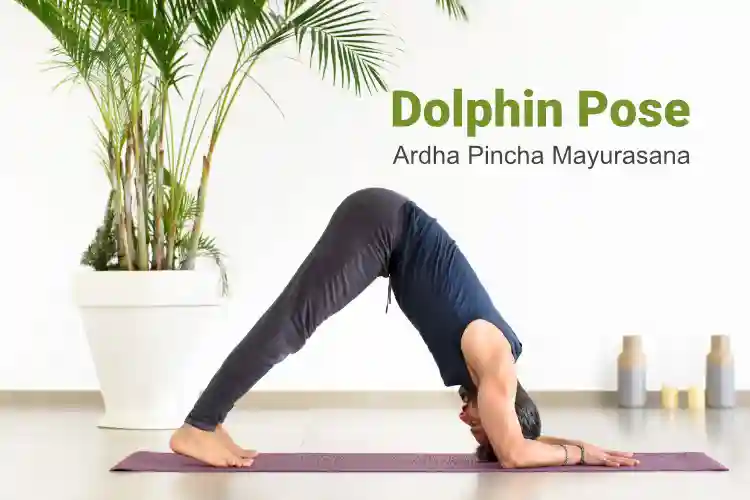Ardha Pincha Mayurasana - An Expert Guide with Details

While the English translation of Ardha pincha mayurasana is “half feather peacock pose,” it is more generally known in the West as “dolphin pose.” One of the intriguing effects of this asana is that it has been attributed to alleviating stress, as well as beneficial in relieving moderate depression.
Table of Content
Definition
Ardha pincha mayurasana is a soothing and energising asana that can be used to reinforce and stretch different parts of the body.
What Does Dolphin Pose Mean
Dolphin pose is a variant of the downward-facing dog pose that can be used as an alternative. This pose will help you relax and calm the mind. If the body isn’t strained, it can also be used as a meditative posture.
Kneel on the floor in dolphin pose, with your hands and arms aligned as if you were in a downward dog. As in a downward dog, the legs are straightened, lengthening the tailbone, and the forearms are pressed close to the ground.
Dolphin pose is also known in Sanskrit as ardha pincha mayurasana. This pose is beneficial for extending several body parts at the same time. It is also a soothing and calming pose since it is a slight inversion. This is an excellent posture to begin exploring the meditative side of yoga for the first time.
Practitioners with high blood pressure, asthma, or sciatica will benefit greatly from this pose. It’s also most popular among women and as a more realistic alternative to downward dog pose for women who want to relieve menstrual symptoms. Dolphin pose is a good warm-up for feathered peacock pose (pincha mayurasana), also known as forearm stand.
How to Do Dolphin Pose
It can be difficult till you’re in and remain in this role as a learner. Simply loosen up your shoulders to assist you. Lift your knees on a rolled-up mattress and press your wrists firmly to the ground for this.
Step-by-Step Instructions
- Get down on your hands and knees on the concrete. Set your knees directly below your hips, forearms on the floor, and shoulders directly above wrists. Firmly press your forearms into the floor and your palms together.
- Exhale and raise your knees away from the floor, curling your toes under. Keep the knees slightly bent and the feet lifted off the floor at first.
- Pull your tailbone away from the back of your pelvis and lightly rub it against your pubis. Raise the sitting bones toward the ceiling toward this resistance, and pull the inner legs up into the groynes from the inner ankles.
- Continue to vigorously push your forearms into the floor. Firm your shoulder blades toward your back, then pull them away from your neck and toward your tailbone. Keep your head between your upper arms, not dangling or pressed against the floor.
- You can straighten your knees if you like, but it’s better to keep them bent if your upper back rounds. Continue to raise the top of your sternum away from the floor and lengthen your tailbone away from the pelvis.
- Keep your time between 30 seconds and one minute. With an exhale, lower your knees to the floor.
Dolphin Pose: Different Variations for Optimal Benefit
Dolphin Pose helps to strengthen your arms and core. Going upside down will feel extremely liberating, whether for a few breaths in a pose like Adho Mukha Vrksasana (Handstand) or for several minutes in a pose like Sirsasana (Headstand). Inversions have a variety of physical, mental, and emotional advantages. They do, however, necessitate stamina, versatility, and trust in reversing your normal gravity relationship, all of which can take time to grow. If your body or mind aren’t quite ready for a complete inversion, you may want to try Dolphin, a multifaceted pose.
Dolphin pose benefits are numerous, whether you practise it to become more familiar with the concept of turning upside down or as a warm-up for Pincha Mayurasana (Forearm Balance).
You’ll gain greater range of motion in your back and shoulders, as well as power in your arms and core, as you get used to bearing weight on your hands, arms, and upper body, with continued practise. To put it another way, befriend Dolphin and you’ll gain access to a world where your cartwheels are the standard.
Lift Up by Pressing Down
Use the arm position associated with a classic Headstand for the first Dolphin variant, but hold the head off the floor. This will help you loosen up your middle and upper back, as well as stretch and strengthen your shoulders, which are commonly tight in students. Kneel in the middle of your mat and interlace your fingers, slipping one pinkie inside the opposite palm to create a flat surface from your outer hands to wrists. With your forearms in a V shape, place your hands on the concrete. Your elbows should be a couple inches ahead of your knees and shoulder-distance apart. Keep the inner and outer wrists in a straight line. (to keep your palms from opening) and tightly press down on your elbows with your outer fists.
In this position, perform a karate chop to ensure that you are making solid contact with the floor—the ability to forcefully root down is what gives Dolphin its dignity and vitality. You can lift yourself up by pressing down. Consider a tennis ball: it doesn’t bounce very far if you actually drop it. When you throw it down with force, on the other hand, it bounces up far higher. Actively press down with your forearms and use this touch to lift your shoulders away from the floor, away from your ears, and away from compression.
Keep looking down at your feet as you rise up into Dolphin by tucking your toes under and pushing your hips back and up as if you were moving into Downward-Facing Dog once you’ve formed this link between the base of the pose and your shoulders. With your forearms, push the floor away so that your shoulders and hips stretch in a straight line away from your elbows, then straighten your legs and reach your heels toward the floor. Allow your head to hang freely to relieve tension in your stomach, and lengthen your torso evenly from front to back. Your front ribs can poke toward the floor if you’re flexible; If they do, try shifting your lower ribs toward your back body to relax them a little. If you’re naturally stiff (particularly in your hamstrings), check to see if your spine is rounded and lengthen it, bending your knees slightly if necessary. Release your knees to the floor and sit back on your heels after 10 to 15 breaths.
Activate Your Core
The next variant is a shoulder and core-strengthening version of Plank Pose. You’ll use the same arm position as in Pincha Mayurasana, an inversion. Tight shoulders, on the other hand, cause elbows to splay and hands to drift toward each other. Using a block and a strap will help you avoid this and find the proper alignment. Create a loop in a brace with your hands. When you tighten the buckle, make sure the loop just above your elbows is large enough to hold your elbows shoulder-distance apart. Then, at the front of your mat, put a block at its lowest height. Place your hands on either side of the block and make L shapes with your thumbs and forefingers.
Step your feet back after you’ve built your foundation so that your body is long and straight like a plank of wood. Your shoes should be stacked over the balls of your feet, and your feet should be hip-distance apart. When your hips are at shoulder height, your shoulders will stack over your elbows. Push your heels back while extending your sternum forward, and raise the top of your thighs to the ceiling while tucking your tailbone to engage your heart. These movements will compress your heart and make you feel as though your lower belly is supporting your lower back. All of your postures, particularly inversions, will benefit from creating abdominal integrity. Keep your gaze forward for 10 to 15 breaths.
Dolphin Pose: To Find a Balance
Take the basic shape and behaviour from the first iteration and combine them with the more complicated arm position from the second for the final version of Dolphin. With your wrists and elbows shoulder-distance apart, align your forearms parallel to each other. Tuck your toes under and raise your hips.
Observe how keeping the elbows from moving apart becomes more difficult without the help of the block and strap. Use the props if you need to hold your forearms parallel. When you splay your elbows, the heads of your upper arm bones fall inward, creating congestion in your neck and upper back—Both of these elements should be avoided in Dolphin and other inversions.
Lift the shoulders and hips up and away from the base of the pose by pressing down from wrist to elbow. Root down with your inner hands and wrists in particular, as they appear to curl up in this position. Shift your shoulder blades toward your stomach and your chest toward your thighs while you stretch your hips back and up.
If you’re more flexible, make sure you’re not overstretching the front of your body and puffing your front ribs and armpits against your thighs as you do this. Instead, lengthen both the front and back bodies equally, softening the front ribs and firming the triceps so you don’t sink into your armpits (you’ll know if your ears aren’t in line with your upper arms).
Bind energetically to the floor underneath you and use the touch to lift your spine and hips toward the ceiling. Press your quadriceps back if you can straighten your legs without rounding your spine; otherwise, soften your knees so it is easier.
Take note of the good stretch in your shoulders and back, as well as the strength you’re employing to raise yourself off the ground. This is the essence of yoga: a fusion of seemingly diametrically opposed elements to create a posture that is both secure and solid while still being spacious and expansive.
Advantages of Ardha Pincha Mayurasana
- Calms the mind and aids in the relief of moderate depression and stress
- Stretches shoulders, hamstrings, calves, and arches
- Strengthens arms and legs
- Aids in the relief of menopause symptoms
- Relieves menstrual pain
- Aids in the prevention of osteoporosis
- Enhances digestion
- Relieves headaches, insomnia, back pain, and exhaustion
In a Nutshell,
Ardha Pincha Mayurasana or Dolphin Pose is one of the incredible yoga asanas hoarding in a lot of benefits for the practitioner. Whether it is strengthening your legs or arms, this yoga pose helps in building your overall strength.
You may also like:-
Salabhasana (Locust Pose) – Significance and Benefits.
Ardha Pincha Mayurasana – An Expert Guide with Details.
What Is Yoga Nidra Sleep Guided Meditation?
















